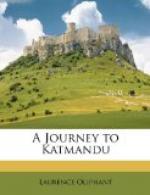As I approached the temple I remarked some handsome houses, three or four stories in height, which we were informed were the residences of some of the priests. As they were good specimens of the architecture of this country, I may as well describe them here.
The whole front of the Nepaulese houses presented a mass of curiously carved wood-work, so that the beautiful flat brick of which they were built (and for the manufacture of which Nepaul is famous) was scarcely discernible amidst the intricate tracery which surrounded every window, and hung in broad wooden fringes from the balconies: these are formed under the eaves, which project five or six feet, and are supported by rafters, on which quaint figures are depicted in all sorts of impossible postures; the space between the rafters is also filled by carved wood, forming a sort of balcony or small room, generally occupied by the women of the establishment, and flat faces peer out of grotesque windows as you pass beneath.
But it must not be imagined that the same attraction exists here as in other Oriental countries to induce you to return their gaze. On the contrary, the female portion of the Nepaulese community is anything but attractive. I have seldom seen a race look more debased and squalid. Sometimes a florid tint about the nose and cheek-bones seems to hint at an affection for the bottle; while their flowing or rather tangled locks, and slovenly dress, might fairly induce the suspicion that they had but lately parted company with it. The Newar women, however, were ladylike in their appearance, when compared with some of the Bootya tribe with whom I afterwards made acquaintance.
It would, perhaps, be hardly fair to these copper-coloured ladies to judge entirely from their appearance, but, from what I could learn, it did not belie them, except, of course, as regards their friendship for the bottle, drunkenness being a vice which is not prevalent, though the strictness with respect to intoxicating liquors, so remarkable amongst the Hindoos of the plains, is by no means observable among the hill tribes.
The dress of the men consists of a short coat, not unlike a shooting-coat, reaching about half-way to the knees, and composed of a coarse cotton fabric manufactured in the country, from a tree which is a native of some of the lower valleys, but which I did not see in the valley of Katmandu.




